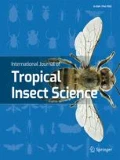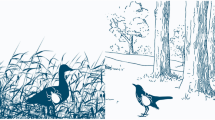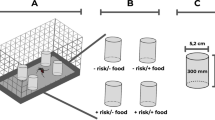Abstract
Mosquitoes (Diptera: Culicidae) are the group of insects, with great significance for the medical area that colonize different anthropogenic environments. This study reports the diversity of mosquitoes from four urban parks: Acuaparque (AP), Parque Ecológico del Poniente (PEP), Parque Ecológico Metropolitano del Sur (PEM) and Parque Zoológico del Centenario (PZC) in the city of Merida, Yucatan, located in southern Mexico. Mosquito larvae were collected by direct inspection from breeding sites and adult specimens were collected using CDC Backpack aspirators and Mosquito-Magnet® traps. A total of 349 specimens of 6 genera and 14 species were collected and identified. Aedes aegypti, Culex coronator, Culex nigripalpus, Culex interrogator, Aedes taeniorhynchus, Culex quinquefasciatus and Culex salinarius were the most abundant and widely distributed species. The highest numbers of species registered were 12 and 11 (for AP and PEP parks, respectively), and similar species composition. The results show that recreational parks can harbor various species of mosquitoes, including some of public health importance.


Similar content being viewed by others
References
Alvarez T, De Lachica F (1991) Zoogeografía de los vertebrados de México. SITESA, México D.F., pp 65
Ayuntamiento de Mérida (2017) Inventario del Arbolado Urbano de la Ciudad de Mérida. p 14. http://www.merida.gob.mx/sustentable/plan-de-infraestructura-verde.phpx. Accessed 26 Apr 2021
Baak-Baak CM, Cigarroa-Toledo N, Arana-Giardia R, Chi WA, Chan JA, Machain-Williams C, Torres-Chable OM, Ortega-Morales A, Moo-Llanes DA, Elizondo-Quiroga A, García-Rejón JE (2016) Mosquito fauna associated with Aedes aegypti (Diptera: Culicidae) in Yucatan state of southeastern Mexico, and checklist with new records. Fla Entomol 99:703–709
Bond JG, Moo-Llanes DA, Ortega-Morales AI, Marina CF, Casas-Martínez M, Danis-Lozano R (2020) Diversity and potential distribution of culicids of medical importance from the Yucatan Peninsula, Mexico. Public Health Mex 62:379–387. https://doi.org/10.21149/11208
Cauich-Kumul R, Coronado-Blanco JM, Ruiz-Ruiz J, Segura-Campos M, Koyoc-Cardeña E, Navarrete-Carballo J, Jimenez HH, Martin-Park A, Manrique-Saide P (2018) Survey of the Mosquito Species in Maxcanu, Yucatan, Mexico. J Am Mosq Control Assoc 34:128–130. https://doi.org/10.2987/17-6727.1 (PMID: 31442149)
Carpenter S, LaCasse W (1955) Mosquitoes of North America. University of California press, London, UK, p 360
de Carvalho GC, Ceretti-Junior W, Barrio-Nuevo KM, Wilk-da-Silva R, de Christe R, O, Bicudo de Paula M Vendrami D, Multini LC, Evangelista E, Camargo AA, Souza LF, Wilke A, Medeiros-Souza AR, Marrelli M (2017) Composition and diversity of mosquitoes (Diptera: Culicidae) in urban parks in the South region of the city of São Paulo. Brazil Biota Neotrop 17
Clark G, Seda H, Gubler D (1994) Use of the “CDC backpack aspirator” for surveillance of Aedes aegypti in San Juan, Puerto Rico. J Am Mosq Control Assoc 10:119–124
Contreras-Perera YJ, Briceño-Mendez M, Flores AE, Manrique-Saide P, Palacio-Vargas JA, Huerta H, Martin-Park A (2019) New record of Aedes albopictus in a suburban area of Mérida, Yucatan. Mexico J Am Mosq Control Assoc 35:210–213
Couto-Lima D, Madec Y, Bersot MI, Silva S, Albuquerque M, Barreto F, Vazeille M, Costa PF, Lourenço-de-Oliveira R, Failloux A (2017) Potential risk of re-emergence of urban transmission of Yellow Fever virus in Brazil facilitated by competent Aedes populations. Sci Rep 7:4848. https://doi.org/10.1038/s41598-017-05186-3
Darsie R, Ward R (1981) Identification and geographical distribution of the mosquitoes of North America, North of Mexico. J Am Mosq Control Assoc Mosq Syst Supplement 313
Dávalos-Becerril E, Correa-Morales F, González-Acosta C, Santos-Luna R, Peralta-Rodríguez J, Pérez-Rentería C, Ordoñez-Álvarez J, Huerta H, Carmona-Perez M, Díaz-Quiñonez JA, Mejía-Guevara MD, Sánchez-Tejeda G, Kuri-Morales P, González-Roldán JF, Moreno-García M (2019) Urban and semi-urban mosquitoes of Mexico City: A risk for endemic mosquito-borne disease transmission. PloS One 14:e0212987. https://doi.org/10.1371/journal.pone.0212987.PMID:30840661;PMCID:PMC6402764
Díaz-Badillo A, Bolling BG, Pérez-Ramírez G, Moore ChG, Martínez-Muñoz JP, Padilla-Viveros AA, Camacho-Nuez M, Díaz-Pérez A, Beaty BJ, Muñóz ML (2011) The distribution of potential West Nile virus vectors, Culex pipiens pipiens and Culex pipiens quinquefasciatus (Diptera: Culicidae), in Mexico City. Parasit Vectors 4:70
Donald CL, Siriyasatien P, Kohl A (2020) Toxorhynchites Species: A Review of Current Knowledge. Insects 11:747. https://doi.org/10.3390/insects11110747
Dzul MF, Manrique-Saide P, Che A, Rebollar E (2010) Mosquitos of Yucatán. In: Durán R, Méndez M (eds) Biodiversity and Human Development in Yucatán. PPD-GEF, CONABIO, SEDUMA, Mérida 232
Estrada-Medina H, Jiménez-Osornio JJ, Álvarez-Rivera O, Barrientos-Medina RC (2019) The Yucatán karst: its origin, morphology and biology. University Act 29:e2292. https://doi.org/10.15174/au/2019.2292
Foster WA, Walker ED (2019) Mosquitoes (Culicidae). In: Mullen JR, Murden LA (eds) Medical and Veterinary Entomology. Academic Press, UK, pp 261–325
García-Luna SM, Weger-Lucarelli J, Rückert C, Murrieta RA, Young MC, Byas AD, Fauver JR, Perera R, Flores-Suarez AE, Ponce-Garcia G, Rodriguez AD, Ebel GD, Black WC 4th (2018) Variation in competence for ZIKV transmission by Aedes aegypti and Aedes albopictus in Mexico. PLoS Negl Trop Disl 12:e0006599. https://doi.org/10.1371/journal.pntd.0006599.PMID:29965958;PMCID:PMC6044546
García E (2004) Modifications to the Köppen climate classification system Book series no. 6, 5th. Ed., Institute of geography, UNAM, Mexico
Gutiérrez-Martínez N, Fernández-Martínez Y (2016) The design of contemporary public space. The parks of Mérida, Yucatán. Legado De Arquitectura y Diseño, ISSN 2007–3615:19–30
Harbach R (2007) The Culicidae (Diptera): A review of taxonomy, classification and phylogeny. Zootaxa 1668:591–638. https://doi.org/10.11646/zootaxa.1668.1.28
Harbach R (2020) Mosquito Taxonomic Inventory: valid species. http://mosquitotaxonomic-inventory.info/valid-species-list. Accessed Jan 2020
Hendy A, Hernandes-Acosta E, Aparecida B, Ferreira N, Valério D, Mendonca C, Guimaráes MC, Buenemann M, Vasilakis N, Hanley K (2020) Into the woods: Changes in mosquito community composition and presence of key vectors at increasing distances from the urban edge in urban forest parks in Manaus. Brazil Acta Trop 206:105441
Hill MO (1973) Diversity and evenness: a unifying notation and its consequences. Ecology 54:427–432
Hsieh T, Ma K, Chao A (2016) iNEXT: an R package for rarefaction and extrapolation of species diversity (Hill numbers). Methods Ecol Evol 7:1451–1456
Ibáñez-Bernal S, Martinez-Campos C (1994) Key for the identification of common mosquito larvae in urban and suburban areas of the Mexican Republic (Diptera: Culicidae). Folia Entomol Mex 92:43–73
Ibáñez-Bernal S (2017) Update of the Catalog of Taxonomic Authorities of the Diptera (Diptera: Insecta) of Mexico. Institute of Ecology AC. Environment and Sustainability Network. Final report-SNIB-CONABIO project JE006. Mexico City. http://www.conabio.gob.mx/institucion/proyectos/resultados/InfJE006.pdf.Accessed 12 Jan 2020
Instituto Nacional de Estadística y Geografía (INEGI) (2020) Censo de población y vivienda. https://www.inegi.org.mx/app/buscador/default.html?q=Yucat%C3%A1n+#tabMCcollapse-Indicadores. Accessed 26 Apr 2021
Islebe GA, Sánchez-Sánchez O, Valdéz-Hernández M, Weissenberger H (2015) Distribution of Vegetation Types. In Biodiversity and Conservation of the Yucatán Peninsula; Islebe GA, Calmé S, León-Cortés JL, Schmook B, Eds.; Springer International Publishing: Cham, Switzerland 39–53
Jost L (2006) Entropy and diversity. Oikos 113:363–375
Linares- Hernández GI (2020) Relaciones especies-área-energía para la comunidad de aves de la ciudad de Mérida. Disertation, Centro de Investigación Científica de Yucatán, A. C
Manrique-Saide P, Delfín-González H, Ibáñez-Bernal S (2001) Horseflies (Diptera: Tabanidae) from protected areas of the Yucatan península, Mexico. Fla Entomol 84:352–362. https://doi.org/10.2307/3496492
Manrique-Saide P, Davies CR, Coleman PG, Rebollar-Tellez E, Che-Medoza A, Dzul-Manzanilla F, Zapata-Peniche A (2008) Pupal surveys for Aedes aegypti surveillance and potential targeted control in residential areas of Mérida, México. J Am Mosq Control Assoc 24:289–298. https://doi.org/10.2987/5578.1 (PMID: 18666538)
Manrique-Saide P, Escobedo-Ortegón J, Bolio-González M, Sauri-Arceo C, Dzib-Flores S, Guillermo-May G, Ceh-Pavía E, Lenhart A (2010) Incrimination of the mosquito, Aedes taeniorynchus, as the primary vector of heartworm, Dirofilaria immitis, in coastal Yucatán, Mexico. Med Vet Entomol 24:456–460
Medeiros-Sousa AR, Fernandes A, Ceretti-Junior W, Wilke ABB, Marrelli MT (2017) Mosquitoes in urban green spaces: using an island biogeographic approach to identify drivers of species richness and composition. Sci Rep 7:17826
Miranda F, Hernández-XE (1963) Los tipos de vegetación de México y su clasificación. Bot Sc 28:29–179. https://doi.org/10.17129/botsci.1084
Moreno CE, Barragán F, Pineda E, Pavón NP (2011) Reanalysis of alpha diversity: alternatives to interpret and compare information on ecological communities. Rev Mex Biodivers 82:1249–1261
Multini LC, de Souza AL, Marrelli MT, Wilke ABB et al (2020) The influence of anthropogenic habitat fragmentation on the genetic structure and diversity of the malaria vector Anopheles cruzii (Diptera: Culicidae). Sci Rep 10:18018. https://doi.org/10.1038/s41598-020-74152-3
Muñoz-Cabrera L, Ibáñez-Bernal S, Corona-Vargas M (2006) Mosquitoes (Diptera: Culicidae) from Tlaxcala, Mexico. I: Annotated list of species. Folia Entomol Mex 45:223–271
Nájera-Vázquez R, Dzul F, Sabido M, Tun-Ku E, Manrique-Saide P (2004) New Distribution Records of Mosquitoes (Diptera: Culicidae) for Yucatán. México Entomol News 115:181
Navarrete- Carballo J, Chan Espinoza D, Huerta H, Trujillo- Peña E, López-Platas J, Vivas-Pérez D, Damasco- Córdova K, Medina-Barreiro A, Delfín-González H, Manrique-Saide P, Martin-Park A (2020) Diversity of Culicidae and Tabanidae (Diptera) and new record of Uranotaenia sapphirina from the archaeological site of X'cambó, Yucatan, Mexico. Int J Trop Insect Sci. https://doi.org/10.1007/s42690-020-00329-y
Organización Panamericana de la Salud / Organización Mundial de la Salud (OPS/OMS) (2021). Actualización Epidemiológica: Dengue, chikunguña y Zika en el contexto de COVID-19. Washington, D.C. https://www.paho.org/es/documentos/actualizacion-epidemiologica-dengue-chikungunya-zika-contexto-covid-19-23-diciembre-2021. Accessed 10 Apr 2022
Ortega-Morales AI, Bond G, Méndez-López R, Garza-Hernández JA, Hernández-Triana LM, Casas-Martínez M (2018) First record of invasive mosquito Aedes albopictus in Tabasco and Yucatan, Mexico. J Am Mosq Control Assoc 34:120–123
Palafox-Juárez EB, López-Martínez JO, Hernández-Stefanoni JL, Hernández-Nuñez H (2021) Impact of Urban Land-Cover Changes on the Spatial-Temporal Land Surface Temperature in a Tropical City of Mexico. ISPRS Int J Geo-Inf 10:76. https://doi.org/10.3390/ijgi10020076
Pennington T, Sarukhán J (1998) Tropical Trees of Mexico. UNAM-Fondo de Cultura Económica, México, D. F, México 523
Pérez-Medina S and López-Falfán I (2015) Áreas verdes y arbolado en Mérida, Yucatán. Hacia una sostenibilidad urbana. Econ soc territ 15: 47
Rowbottom R, Carver S, Barmuta LA, Weinstein P, Allen GR (2017) Mosquito distribution in a saltmarsh: determinants of eggs in a variable environment. J Vector Ecol 42:161–170
Rosado-Agilar J, Rodríguez- Vivas R, Castillo-López D, Mora-Camacho O, Cabrera-Borges W, Flota-Burgos G, Trinidad- Martínez E (2016) Nematodiasis with zoonotic potential of wild cats and canids in captivity conditions in southeastern Mexico. Scientific Work in Chiapas 11:76–80
Secretaría de Desarrollo Sustentable (SDS) (2021) Parque Ecológico Metropolitano del Sur de Mérida, YUMTSIL. https://sds.yucatan.gob.mx/parque-ecologico-metropolitano-yumtsil/index.php. Accessed 3 May 2021
Servicios de Salud de Yucatán (SSY) (2013) Programa de Prevención y Control del Dengue, Yucatán 2013. Documento Interno de la Coordinación Estatal de Vectores. Mérida: Gobierno del Estado
Schneider JR, Mori A, Romero-Severson J, Chadee DD, Severson DW (2007) Investigations of dengue-2 susceptibility and body size among Aedes aegypti populations. Med Vet Entomol 21:370–376. https://doi.org/10.1111/j.1365-2915.2007.00699.x (PMID: 18092975)
Steffan WA, Evenhuis NL (1981) Biology of Toxorhynchites. Annu Rev Entomol 26:159–181. https://doi.org/10.1146/annurev.en.26.010181.001111
Suesdek L (2019) Microevolution of medically important mosquitoes - A review. Acta Trop. Mar 191:162–171. https://doi.org/10.1016/j.actatropica.2018.12.013. Epub 2018 Dec 7. PMID:30529448
Szeroczyńska K, Zawisza E (2015) Cenotes – Lakes of the Yucatan Peninsula (Mexico). Stud Quat 32:53–57. https://doi.org/10.1515/squa-2015-0005
Ulloa-García (2019) Biodiversity of mosquitoes and disease vectors. Rev Biomed 30. https://doi.org/10.32776/revbiomed.v30i3.741
Williams CR, Long SA, Russell RC, Ritchie SA (2006) Field efficacy of the BG-sentinel compared with CDC backpack aspirators and CO2-baited evs traps for collection of adult Aedes aegypti in cairns, Queensland, Australia. J Am Mosq Control Assoc 22:296–300
Wilke AB, Medeiros-Sousa AR, Multini LC, Ceretti-Junior W, Marrelli MT (2017) Mosquito population diversity and abundance patterns in two parks in São Paulo, Brazil. J Am Mosq Control Assoc 33:67–70. https://doi.org/10.2987/16-6568.1 (PMID: 28388319)
Zapata-Peniche A, Manrique-Saide P, Rebollar-Téllez E, Che-Mendoza A, Dzul-Manzanilla F (2007) Identification of mosquitoes (Diptera: Culicidae) from Mérida, Yucatán, México and their main breeding sites. Rev Biomed 18:3–17
Acknowledgements
Abdiel Martin-Park is supported by Cátedras-CONACYT program. The authors acknowledge the field-surveillance team of Universidad Autónoma de Yucatán for technical assistance in the mosquito sampling. We give special thanks to Adriana E. Flores for her comments and corrections for this manuscript and both Suzanna Rodriguez-Shugert and Brenda Herrera for grammatical corrections.
Author information
Authors and Affiliations
Contributions
Conceptualization: JGR, YCP. Field work: YCP, JGR. Identification species: YCP, JGR. Data curation: YCP, JGR. Formal analysis: YCP, MBM, RPK, AMP. Investigation: YCP, JGR, AMP, PMS. Methodology: YCP, JGR, AMP, PMS. Project administration: JGR, YCP. Resources: JGR, YCP, PMS. Software: RPK, MBM. Supervision: JGR, PMS. Validation: YCP, JGR, AMP, PMS. Visualization: YCP, PMS, AMP. Writing – original draft: YCP, MBM, RPK, JGR. Writing – review & editing: YCP, AMP, PMS, HDG.
Corresponding author
Ethics declarations
Ethics approval
Not applicable.
Consent to participate
Not applicable.
Consent for publication
Not applicable.
Conflict of interest
The authors declare that they have no conflict of interest.
Additional information
Publisher's Note
Springer Nature remains neutral with regard to jurisdictional claims in published maps and institutional affiliations.
Rights and permissions
About this article
Cite this article
Contreras-Perera, Y.J., García-Rejón, J.E., Briceño-Méndez, M.A. et al. Diversity of mosquitoes (Diptera: Culicidae) in public parks of Merida, Yucatan, Mexico. Int J Trop Insect Sci 42, 3263–3272 (2022). https://doi.org/10.1007/s42690-022-00809-3
Received:
Accepted:
Published:
Issue Date:
DOI: https://doi.org/10.1007/s42690-022-00809-3




